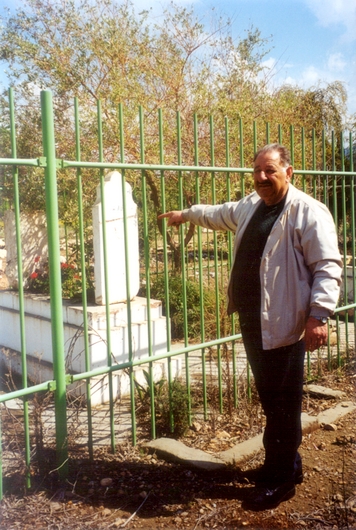
Abbas Zeinidin pointing to the tomb of Sami Taha, Beled al-Sheikh, near Haifa
|
 Abbas Zeinidin pointing to the tomb of Sami Taha, Beled al-Sheikh, near Haifa |
Abbas Zeinedin, Haifa, April 7, 1999:
|
|
Abbas works in Al-Ittihad, and it's there that I meet him to record his recollections of the Nakbeh. He's Lebanese in origin, from a village near Tibnin, and came as a young boy with his older brother to Nazareth. Around twelve years old 1948, interested in everything that was happening around him, he gives a detailed account of conditions in Nazareth as refugees from Haifa and surrounding villages streamed into it, and of its final surrender.
Why the Zeinedin siblings came to Nazareth, and why they remained there after fighting intensified, is not explained in Abbas's account. They may have been orphans, and his older brother a migrant worker seeking better wages; or perhaps a communist escaping persecution in Lebanon. In 1952, Abbas went to Haifa to attend a rally of Communist youth, and found a job there in an Arab workers' cooperative. His interest in Haifa and its history moved him to ask people who had stayed on there what had happened during and after the expulsions. They told him that Israel had made a concentration camp in Wadi Nisnas and gathered all Arabs there. Life was very insecure. A defence committee was formed by leaders such as Toufiq Toubi to protect Palestinians from Jewish gangs. He tells about the changing of street names; the killing of three Palestinian young men in 1961, and the enormous funeral demonstration that followed; and about the steady influx of Palestinians from rural areas, though the authorities forbade this. After the recording is over, Abbas drives me out to Beled al-Sheikh, a few kilometers to the north of Haifa. Its people fled after an early massacre, on April 25, 1948; I know some of their descendants in Shatila camp (Lebanon). The old village has gone completely, covered by new suburban housing, but |
the cemetery is still there, still containing the grave of Sheikh Qassam Izzedin, who organized resistance cells in and around Haifa, and sparked Palestinian revolt against the British Mandate. The other Palestinian leader buried here is Sami Taha, workers' union organizer, whose assassination in 1947 was suspected of being ordered by the Mufti.
The Israeli authorities want to drive a road through the heart of the cemetery, now disused. But local resistance has managed to prevent this so far.
Abbas Zeinedeen speaks: |
| 5. Near Bint Jbeil. |
[Samia Shehadeh] [Leaving Haifa] Copyright©2005 |
|